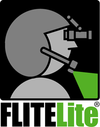MIL-STD-3009 NVIS Night Vision Standards for Military Aircraft
MIL-STD-3009 was developed by the Department of Defense in February 2001 and superceeded MIL-L-85762A. It specifies that NVIS White for crew cockpit and utility lighting. NVIS Green A is grand fathered into the cockpit for certain applications, but not for new applications.
The chromacity of NVIS White makes it a full spectrum light even though is appears to have a green tint. NVIS Green that we selected for use with our lights is a 565nm Green centered light with excellent properties and compatibilities. If you use our lights you will notice the difference under googles.
Visible light can be split into the three primary colors, red, green and blue. The eye needs two primary colors to see 'white'. NVIS White, in simple terms is blue range through the green range. NVIS goggles filters allow a thin band of green light though the lens - so that users can see heads up displays and and other required applications through the goggles.
The level of light with respect to the chromacity is important due to this leak (filter) in the goggles. FLITELite meets and exceeds non-binding RFP standards, AND meets the modern, more stringent MIL-STD-3009, which is a binding requirement specified by the military. Approved by the US Army Night Vision Lab and certified by Esterline when using FLITELite specific color spectrum LED and filter combinations.
General Aviation pilots can benefit from this technology. This light spectrum and intensity is perfect for general night vision use as well.
FLITELite minimizes the crossover zone by using a special combination of LED's and Filter material. The filter material ensures that the light greater than 600 nm is not transmitted.
The image below shows an instrumentation with some Non-Compatible components within the cockpit. In this image, the lip light is on...and notice no indication from the image...which is what we need, visible only to the naked eye under the googles.

